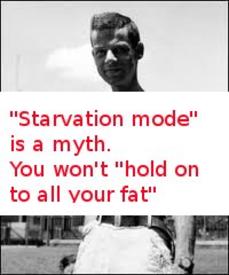Subtract BMR from exercise calories?
Options
Replies
-
In my opinion you are right and it should be subtracted,
and in addition to that, MFP's way of Total calorie calculation method has got another problem and that is the calorie differential between the calories burned in sleeping and the calories burned in Resting which for example for a weight of 67kg (mine):
- The calories burned in Resting is: 71cal per hours (considering 16 hours Resting)
- The calories burned in Sleeping is: 64cal per hours (considering 8 hours Sleeping)
So I believe in the Daily Summery the calorie of Resting shall be subtracted from exercise proper to the time of exercise.
I also hereby invite other members to participate in this topic and let us know their way of calculation.0 -
I subtract sedentary calories from the cals reported on my HRM, because the HRM clocks up about 2000 cals a day equivalent while I'm sitting at the computer0
-
Thank "yarwell" for our contribution, and I have found an article emphasizing on what you are saying as follows (I paste the text)
=======================================
The Math Behind Weight Loss: Caloric Deficit explained
Posted on July 4, 2012 by Courtney D
Losing weight comes down to creating a “caloric deficit.” That is, burning more calories a day than you eat.This takes into account more than your BMR.
BMR = basal metabolic rate. This is how many calories you burn from existing. If you sat around all day and did absolutely NOTHING your body would burn this many calories just to exist.
TDEE = BMR + activity level, or “total daily energy expenditure”. Since the average person doesn’t sit around on the couch and not move at all, this takes into account other things. For example, a sedentary person (who works a desk job and doesn’t exercise) may have a TDEE slightly above their BMR. Someone who is very active (their job is manual labor, or they lift very heavy multiple times a week) may have a TDEE almost twice their BMR.
How do you calculate your BMR or TDEE? Let’s cut the math - here is my favorite calculator. You input your gender, age, weight, body fat % and “activity level” and it will tell you how many calories you need to maintain, lose weight, etc.
So what is a caloric deficit?
Let’s use a real life example. My BMR is 1550 calories a day, my maintenance is 2,100 calories a day. Based on how often I exercise, how I spend my day, etc. I need to eat 2,100 calories to maintain my weight. If I want to lose weight I need to eat less than 2,100 calories a day. What’s important to note about this number, my maintenance number, is that it takes my TDEE into consideration. I don’t subtract the amount of calories I burn from exercise, that’s already taken into consideration. That’s the definition of TDEE – total daily energy expenditure. It’s already taking into account that I exercise as much as I do, or I’m as active as I am at my job.
If one pound = 3,500 calories, to lose one pound a week I need to have a deficit of 3,500 calories that week. Divided over 7 days, that’s a 500 calorie deficit a day. That means eating 1,600 calories a day for me. It’s also important to remember that your body takes an average. 24 hours is a human invention, as long as you have -3,500 calories a week it doesn't matter what your day to day intake is. It doesn’t matter if these calories are eaten at 5pm, 6am or 12am.
What is NOT a caloric deficit?
When I was sick I used to think that a caloric deficit meant my total numbers for the day were a negative. Basically, I would eat 600 calories a day and then exercise off 1,000 calories and think that I was in a 400 calorie deficit. What I didn't realize is that my body requires a certain amount of calories to exist that’s independent of how many calories I eat a day – that’s my BMR.
The BMR Trap
People who don’t understand what BMR is believe they need to eat less than their BMR. What they’re forgetting is that they do more than sit around all day. Yes, some people live very sedentary lives – they work at a computer desk, only get up to use the bathroom, go home and eat dinner in front of the TV. These people may need to eat at their BMR because they don’t move enough to create a TDEE much higher than their BMR. Others – people who walk from class to class, go to the gym a few times a week, have a job where they’re on their feet all day at a restaurant or as a nurse – these people have a TDEE higher than their BMR. If they eat at their BMR they will find themselves energy deprived, sluggish, and fall into the trap of binging to compensate for their low energy.
=====================================================================================
Ref Link :http://www.barbellsandbeakers.com/2012/07/04/the-math-behind-weight-loss-caloric-deficit-explained/0
Categories
- All Categories
- 1.4M Health, Wellness and Goals
- 392.1K Introduce Yourself
- 43.6K Getting Started
- 259.9K Health and Weight Loss
- 175.7K Food and Nutrition
- 47.4K Recipes
- 232.3K Fitness and Exercise
- 403 Sleep, Mindfulness and Overall Wellness
- 6.4K Goal: Maintaining Weight
- 8.5K Goal: Gaining Weight and Body Building
- 152.8K Motivation and Support
- 7.9K Challenges
- 1.3K Debate Club
- 96.3K Chit-Chat
- 2.5K Fun and Games
- 3.4K MyFitnessPal Information
- 23 News and Announcements
- 999 Feature Suggestions and Ideas
- 2.4K MyFitnessPal Tech Support Questions

